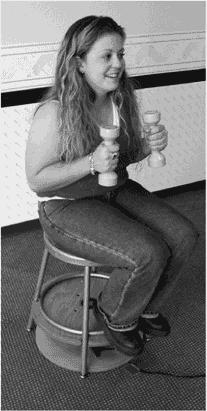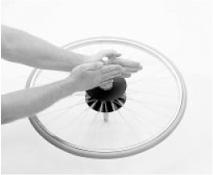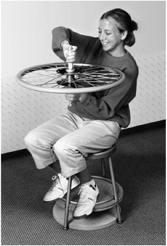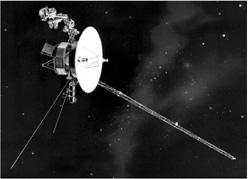125 Physics Projects for the Evil Genius (35 page)
Read 125 Physics Projects for the Evil Genius Online
Authors: Jerry Silver

Like a bicycle, a toy gyroscope becomes stable only when it has sufficient angular momentum to counterbalance the pull of gravity. As an extension, study a gyroscope. Observe what happens when its turning axis is displaced from a stable position. What affects the rate of precession?
A bicycle tire is stable when it is rotating because the tire has angular momentum. The gravitational attraction of the Earth exerts a force that would pull the tire to a horizontal position were it not for the angular momentum of the spinning tire. The interaction of the torque caused by gravity and the angular momentum of the spinning tire results in the precession of the tire about the pivot point.
Moment of inertia. Ice skaters and dumbbells
.
How do ice skaters get spinning so rapidly? Where do they suddenly get the energy? Are they violating conservation of energy? This project explores how this works. The term “dumbbells” should in no way be construed to refer to the skaters or the experimenters (or the writer of this book for that matter). They refer to actual dumbbells.
- (low-friction) rotating stool
- 2 masses, such as a pair of dumbbells (5 kg or greater)
- 1 person
- bicycle tire mounted on an axle
- Sit on the stool while holding the two masses.
- While sitting and balancing on the stool, rotate by pushing off with your feet or by being pushed by someone else.
- Lift both feet from the floor.
- Start with both masses extended out at arm’s length. Then, bring them in close to your body, as shown in
Figure 58-1
.
Extending your arms slows you down; bringing them closer to your body lets you speed up. The rotational speed (or angular velocity) is greater when the masses are closest to the center of rotation. This works best if the stool rotates very freely with a minimum of friction. The stool can be picked up at a yard sale or purchased commercially. There is also usually less friction for a lower-mass person.

Figure 58-1
Pulling in your arms causes you to spin faster. Courtesy PASCO
.
This project is an illustration of the principle of conservation of angular momentum. Angular momentum for a rotating mass increases either if the object rotates faster or if there is more mass at a greater distance from the center of rotation. If the mass is moved further from the center of rotation, the angular velocity must increase to keep the angular momentum constant.
- Sit on the stool with both feet off the floor.
- Swing the bucket in a circular path parallel to the floor.
- Observe the effect of swinging faster and slower.
- Observe the effect of using longer or shorter lengths of rope.
The main thing you notice is you rotate in the
opposite
direction that the bucket is swung. The faster the bucket rotates in a clockwise direction, the faster you rotate in the counterclockwise direction. A longer section of rope turns you faster than a shorter section.
A spinning object, such as a skater, must conserve angular momentum. A movement of mass closer to the center of rotation is compensated by an increase in how fast the skater rotates.
What caused Voyager to point in the wrong direction
?
The Voyager program produced some of the most remarkable spacecraft ever built, providing an unprecedented view of nearly every planet in the solar system. As Voyager II approached the planet Uranus, the spacecraft precisely trained its instruments on that planet’s surface to take advantage of the short window of opportunity to get high-resolution, close-up pictures. Just as the reel-to-reel tape recorder on the spacecraft turned on to capture this historic moment, the orientation of the spacecraft was thrown out of whack and the navigational system had to compensate with last-minute corrections. This project helps you investigate why this could have happened.
- freely rotating stool
- bicycle tire with handles (the more massive the better)
- 2 people
:
- Sit on the rotating stool as before.
- Have someone hand you the bicycle tire that had previously been set into motion. See
Figure 59-1
. - Start with the tire in a horizontal position.
- With the tire rotating, turn the tire upside down (so it is now spinning in the opposite direction).
- Wait a few seconds. Then, turn the tire upside down again.
You will rotate on the stool in the opposite direction from which the tire is rotating. While changing the position of the tire, you will feel a surprisingly strong force, as if you were pushing against a solid wall (
Figure 59-2
).
Starting from rest, both the person and the stool have zero angular momentum. For angular momentum to be conserved, it is necessary that the person on the stool rotate in the opposite direction as the rotation of the tire to preserve angular momentum. When the reel-to-reel tape recorder on Voyager II turned on to record the spectacular images of Uranus for the first time in history, it began turning with a new angular momentum. See
Figure 59-3
. Just like the person on the stool, Voyager began to turn in the opposite direction as the tape recorder to conserve angular momentum.

Figure 59-1
A rotating wheel has angular momentum. Courtesy PASCO
.

Figure 59-2
Angular momentum is conserved. Courtesy PASCO
.
This principle is demonstrated by a toy train running on a circular track. The track is mounted on a platform attached to a freely rotating support. As the train moves in one direction, the platform rotates in the opposite direction to conserve angular momentum.

Figure 59-3
Conservation of angular momentum required a positioning correction aboard Voyager II to compensate for a rotating reel-to-reel tape recorder. Source NASA
.
Angular momentum is conserved. This applies to the case where a system starts with zero angular momentum.
Moment of inertia. The great soup can race or that’s how I roll
.
If two identical cans are released from rest to roll down an incline at the same time, will the top can catch up with the bottom can? Does it matter what the contents of the cans are? This project deals with how things roll.
- 2 cans of thick soup (such as mushroom soup)
- 1 can of thin soup (such as chicken broth)
- incline
- Verify that the external shape of each of the three cans is the same.
- Set up an incline about 1 meter in length. The height should be about 30 cm.
- Hold the two cans of mushroom soup on the incline with a distance of about 10 cm between them, as shown in
Figure 60-1
. Call the top can A and the bottom can B. - Predict what will happen when the cans are released: a) the distance between them will increase b) the distance between them will decrease c) the distance between them will remain the same.
- Place one of the mushroom soup cans (A) and the can of broth (C) on the incline with A 10 cm higher than C.
- Predict what will happen when the cans are released: same options as number 4.
- Try this again with can C as the upper can this time.
The two cans with the same contents will accelerate at the same rate. Because both cans start from rest, the distance between them remains constant. However, the mushroom soup has a greater density than the broth and it will roll more slowly.

Figure 60-1
How will the distance, d, change as the can roll down the slope
?
When an object rolls, some of its energy is associated with moving from one point to another (called
translation
). The more mass the object has and the faster it goes, the more energy it has. In addition, some of the energy of a rolling object is related to the fact that it is rolling. The amount of this rotational energy is related to the way the mass is distributed around the center of rotation. A greater density center (mushroom soup) requires more energy to roll at the same rate as a lower density center (broth).